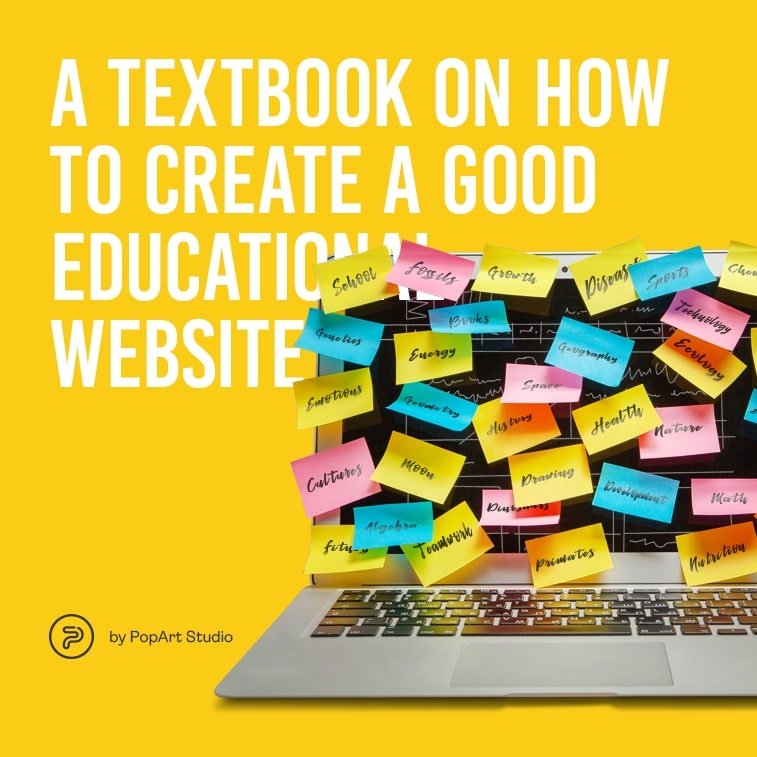Education has never been more popular. Over the last few years, the number of students who pursue further studies has been continually rising, especially those enrolling foreign university programs or specializations abroad. A CV buttressed with conference attendances, workshops participations, or meetups is what employers like to see in a job candidate, whereas rapid technological advancements
and fluctuating social circumstances incessantly create changes in the job market, which is why more and more people flock to vocational retraining courses and seek their chance in an entirely different work field.
With everyone out there looking for a place to learn, whether a physical or an online one, you, as an educator, have to convince them you’re the one who’s going to take them to their dream job. And what better way to attract serious, dedicated, and eager learners than grabbing their attention with a mind-blowing website.
Whether your website is a presentation of an educational institution, a place for teachers’ or students’ resources, an educational blog or an online learning platform, having an all-round well-suited web presence is of utmost importance for your business.
From the website’s name, design concept, the color scheme used, to categorization and SEO, here’s everything you need to know and execute flawlessly, for your business to be the learning hot spot.
Appropriate domain name
Your business name, along with the web address, is the primary attention-grabber your target audience and potential clients will see. Besides creating the first impression, domain name defines your brand, and benefits (or hinders) your SEO efforts.
Therefore, it’s crucial that your name clearly represents who you are and what you offer. Best domain names are short and simple, brandable rather than generic, and are easy to type and pronounce, so avoid numbers, hyphens, dashes, or any characters other than letters.
In case you don’t want to include your brand name as domain address, go for variations of keywords related to your business, such as ‘learn’, ‘teach’, ‘study’, and then the subject matter like a particular language for example. Niche keywords should go at the front of your domain name in order to boost SEO.
For an institution with longer or multi-word name, go for abbreviations, though make sure they actually make sense.
After you’ve chosen your domain name, it’s time to select your domain name extension. Going with .com is definitely the best route to take, though if your desired domain name is taken, try out .net, .org, or .edu, thought this education-specific abbreviation is allowed only to a handful of educational institutions – thought yours perhaps can be one. Your educational website may be playful but its domain name should not seem flippant, so avoid any weird extensions. Also, if you aim for an international audience, and you’re not a national educational institution, disregard country extensions such as .us, .uk, .de, etc.
Overall, ensure both your brand name and domain address are transparent to what you’re doing – whether it’s teaching English, offering baking recipes, or knitting schemes and patterns – your name should tell it.
Ensure website security
Anyone coming to your website with the aim of learning will do one of the following things:
- leave their personal data in order to register and not lose their learning progress
- spend plenty of time going through your website
- download various types of materials, or upload personal files
Because of the safety of your visitors, but also the fact that some web browsers block entering unsecured websites, and that such websites look at serious Google penalties that can sink the website’s ranking, it is imperative to make sure your website has all the necessary certificates.
Optimization and responsiveness
Without good SEO, websites go down the drain. Professionally-done search engine optimization will increase your website positions and ease your future clients find you.
Thanks to the omnipresence of the Internet, much of learning takes place on the go, so make sure your website is optimized for all browsers and device screens, from desktops to mobile phones.
Responsiveness is also a big deal – no one wants to wait minutes for a website to load, therefore, keep your pages light and fast.
Besides, your website is going to be updated regularly, so ensure its agility. The platform where the website is built on has to be suitable for a constantly changed website, and the coding – flawless.
Many educational websites require multimodal content, meaning audio and video files, high-quality images, and so on. Therefore, it’s crucial to build a strong website that will possess the ability to manage these heavy pieces of content.
If you’re aiming even higher, and wish to provide your clients with a one-of-a-kind, unforgettable learning experience, you’re probably going to need professional website development. With a bit of extra effort, you can create an online learning platform where your learners can connect with others, with parents or teachers monitoring their progress.
Also, interactive courses are what draw the learners the most, so assure your website can handle them as well.
Quality homepage and landing pages
Good design doesn’t end with the homepage. This is especially important for educational websites, as people who come to you with the desire to study will definitely have to dig deeper into your website in order to find exercises, materials, or texts they’re interested in.
Landing pages are equally as important because that’s where your visitors will ‘land’ when searching for a particular service you offer. If you’re a foreign language school offering courses of several languages, it would be a good idea to create a separate landing page for each language. Cramming too much information into a single page causes confusion, bad experience, and is a missed chance to gain a client.
It goes without mention that all your pages, both home and landing pages, must have a clearly visible and understood description of what you offer and how your clients benefit from it.
Design suitable for the audience
The educational website is a really wide concept, encompassing everything from a state university to a website with coloring books for children, from a teacher resources blog to a professional website dedicated to development sourcing.
Therefore, a template design simply doesn’t cut here. You’ll need to invest plenty of time and thought into the appearance of your website. Seeking advice from a professional in the field could speed up the process and yield satisfactory results.
Educational websites should be of neutral and affirming colors, such as white, blue, brown, black, green, etc. If your target audience are children aim for colorful design, possibly with some animations or illustrations. For some “more serious” business niches, opt for fewer colors, perhaps a single color scheme and use several complementary shades.
Minimalism isn’t your friend in the educational business, and plenty of empty sections on your website is a space wasted. A successful educational website offers loads of information, content, materials, and images.
Custom illustrations or icons set are other features your website can benefit from, and they’re a great choice for those brands whose business tone is easygoing and friendly.
Avoid using stock photography, especially if your business heavily depends on genuine and quality images. Your website visitors would like to see real satisfied students, a successfully prepped meal, or a real-life crafted item.
Accessibility and inclusiveness
Make your knowledge available to everyone. Besides the already mentioned optimization for different devices, make the extra effort and incorporate software that can assist visually impaired or blind persons to learn from you.
Audio or video materials on an educational website are a huge plus. However, with many people browsing the Internet while they, for example, commute, take into consideration the fact that they may not be able to hear your materials quite well. Thus, provide transcripts for audio materials, and subtitles for videos.
If you’re targeting foreigners as well, keep in mind your website has to be multilingual, and that all information, including contact info and working hours, should be clear for everyone, even those across the world. Creating a multilingual website is tricky – on one hand, it ought to provide identical information across all pages, on the other, there is specific information required only to users from a foreign country – so the overall content structure of such websites has to be thoroughly thought through.
For example, an educational institution aiming foreign students will have to provide info on how to apply for exchange programs, whereas a cooking blog has to offer both European and American cooking measurements.
A worldwide audience also means that your images should represent a variety of people, of different races and nationalities.
Be informative
Always have in mind that people come to you to find stuff out. Of course, their primary goal is to learn the thing you teach, but it is equally crucial for you to be exuberant in providing any information they potentially may need.
If you’re an educational institution, display your contact, phones, addresses, emails, work hours, and provide all information about courses you’re offering, employees, timetables, pricing, etc. On the other hand, if your website is a book or resources depository, highlight whether you allow download for free, or via payment.
It’s also a good idea to include a search box, FAQ, Q&As, and a contact form on your website.
Categorization and hierarchy
Alleviate going through your website with logical and easily-navigable categorization. Divide your video tutorials from textual materials or audio exercises from printable textbooks. Be careful that your categorization is ordered hierarchically.
For example, a cooking website can categorize recipes in multiple ways: according to the type of meal, preparation time, ingredients, etc. Online learning platforms can divide their courses depending on the topic, level of knowledge, content medium, and many other aspects.
Blog
That ‘content is king’ birds know as well. The catchphrase is a marketing mantra, for a reason though – people go online and ask for advice, dos and don’ts, benefits of this, and tips for that.
Use this to your advantage and create an online guide about everything related to your business. Sensible ideas and useful tips, wrapped in quality copywriting and decorated with some good SEO keyword bow will make your blog posts go sky-high.
Language-learning platforms can talk about the cuisine, culture, and history of the home country, programming websites can offer frameworks side-by-sides comparisons or tutorials on the latest coding techniques, whereas educational institutions can present their work, studying experiences, and advice on what after graduating, etc.
Let’s review
You have to give it a lot of thought before diving into the development and design of an educational website. Different niches require diverse websites designs, abilities, and performances, yet, in the end, it boils down to creating a website that will cater to your visitors’ needs and expectations.
Learners will come to you for great and valuable content, but you mustn’t disregard the importance of how that content is presented, accessed, and made responsive. Educational websites are on the rise, so make sure your desire to teach and share knowledge are welcomed by others.





